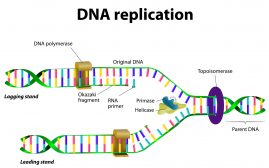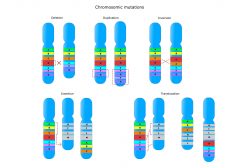Table of Contents
Definition
noun
plural: cytosines
cy·to·sine, ˈsaɪtəsiːn
(biochemistry) A pyrimidine nucleobase that complementary pairs with guanine in DNA and RNA, and has a chemical formula of C4H5N3O
Details
Overview
Nucleic acids such as DNA and RNA are polymers of monomeric nucleotides. Each nucleotide is made up of phosphoric acid, sugar (5-carbon), and nitrogenous base (or nucleobase). There are five nucleobases that serve as fundamental units of the genetic code: (1) adenine, (2) guanine, (3) cytosine, (4) thymine, and (5) uracil. These nitrogenous bases may be classified into purines and pyrimidines. Cytosine is a pyrimdine nucleobase.
Properties
Cytosine is a pyrimidine nucleobase with a chemical formula of C4H5N3O. Pyrimidine is a heterocyclic aromatic organic compound with a single ring (called a pyrimidine ring) with alternating carbon and nitrogen atoms. Cytosine has a molar mass of 111.10 g/mol and a melting point of 320 to 325 °C. It can occur in nucleic acids, such as DNA and RNA. It may also be found as component of nucleoside (nucleobase + sugar deoxyribose or ribose) and nucleotide (nucleoside with phosphate groups).
In DNA and RNA, cytosine matches with guanine forming three hydrogen bonds. Cytosine, though, is relatively unstable and can be converted into uracil (via spontaneous deamination). This alteration can be corrected by DNA repair systems such as by the use of the enzyme uracil glycosylase. If not repaired, this may lead to a point mutation.
Cytosine vs. Thymine vs. Uracil
Cytosine, thymine, and uracil are pyrimidine nitrogenous bases. Cytosine can be differed from the other pyrimidines by having a keto group at position 2 and an amine group at position 4 in its heterocyclic aromatic ring. It has a chemical formula of C4H5N3O. Cytosine complementary pairs with guanine in both DNA and RNA as opposed to thymine and uracil that pairs up with adenine in DNA and RNA, respectively.
Common biological reactions
Pyrimidine biosynthesis differs from purine biosynthesis in a way that purines are synthesized as a nucleotide first whereas pyrimidines form initially as a free base. In humans, pyrimidines are synthesized in various tissues, especially in spleen, thymus, and gastrointestinal tract.
Cytosine, similar to other pyrimidines, is formed from a series of steps, beginning with the formation of carbamoyl phosphate. Carbamoyl phosphate is produced from a reaction involving bicarbonate, glutamine, ATP, and water molecule. This process of forming carbamoyl phosphate is catalyzed by the enzyme carbamoyl phosphate synthetase.
The carbamoyl phosphate is then converted into carbamoyl aspartate through the catalytic activity of aspartate transcarbamylase. Carbamoyl aspartate is next converted into dihydroorotate, which is then oxidized to produce orotate. 5-phospho-α-D-ribosyl 1-pyrophosphate (PRPP), a ribose phosphate, reacts to orotate to form orotidine-5-monophosphate (OMP).
OMP is then converted into other pyrimidines. The enzyme OMP decarboxylase facilitates the decarboxylation of OMP to yield uridine monophosphate (UMP). Eventually, uridine diphosphate (UDP) and uridine triphosphate (UTP) are produced down the biosynthetic pathway by kinases and dephosphorylation of ATPs. UTP can be converted into cytidine triphosphate (CTP) by the amination of UTP via the enzyme CTP synthetase.1
Cytidine and deoxycytidine are nucleosides of cytosine. When phosphorylated with three phosphoric acid groups, they become cytidine triphosphate (CTP) and deoxycytidine triphosphate (dCTP), which are nucleotides that build up RNA and DNA molecules, respectively.
The catabolism of pyrimidine nucleotide cytidine monophosphate (CMP) or cytosine ultimately leads to the formation of the by-products β-alanine, NH3 and CO2. The general degradation pathway is as follows: cytosine » uracil » N-carbamoyl- β-alanine » β-alanine, CO2, and ammonia. Nonetheless, cytosine may be recycled via the salvage pathway. For instance, cytosine may be converted into uracil by deamination. By uridine phosphorylase, uracil is converted into uridine by reacting with ribose-1-phosphate. Through the enzyme nucleoside kinase, uridine is converted into uridine monophosphate (UMP).
Mutation is a change in the nucleotide sequence of a gene or a chromosome. A small-scale mutation characterized by a change of only one nucleotide base in the DNA or RNA molecule is called point mutation. Cytosine is relatively unstable.
It may alter into uracil via spontaneous deamination. When this happens in DNA, repair mechanisms rectify the DNA sequence. For instance, uracil glycosylase removes by cleaving the cytosine-turned-uracil from the DNA. Then, the damaged region is removed and replaced using the other strand (i.e. the complementary strand) as the template.
This type of repair is called base excision repair. Point mutations occurring in non-coding sequences often do not lead to discernible consequences. When coding sequences are involved, a single nucleotide alteration might lead to incorrect decoding during protein translation, especially when the mutation is left unrepaired.
The altered structure of a protein may render the protein impaired by being dysfunctional or non-functional.
Biological functions
Cytosine is one of the five primary (or canonical) nucleobases; the others are thymine, uracil, guanine, and adenine. They are the fundamental nucleobases that make up the genetic code. Nucleic acids such as DNA and RNA molecules contain the genetic code for a particular protein based on the sequence of nucleobases. Nucleic acids hold an important role in cellular functions, heredity, and survival of an organism. Cytosine in the form of cytidine triphosphate (CTP) may serve as a co-factor to enzymes. It can transfer a phosphate to convert adenosine diphosphate (ADP) to ATP. ATP is an energy-rich molecule and is used in various cellular activities and important biological reactions.
Trivia
The isolation and naming of the five nucleobases, including cytosine, is attributed to Albrecht Kossel (a German biochemist). From 1885 to 1901 he and his students discovered them through chemical analyses of the nucleic acids.”’2
Supplementary
Etymology
- German cytosin
IUPAC name
- 4-aminopyrimidin-2(1H)-one
Chemical formula
- C4H5N3O
Abbreviation
- C
Also called
- 4-amino-1H-pyrimidine-2-one
Derived term(s)
- Cytosine arabinoside
Further reading
See also
Reference
- Charma, K. & Somani, D. (2015). Pyrimidine Biosynthesis. Retrieved from Slideshare.net website: ://www.slideshare.net/kskuldeep1995/pyrimidine-biosynthesis-46874172 Link
- The Editors of Encyclopedia Britannica. (2018). Albrecht Kossel German biochemist. In Encyclopædia Britannica. Retrieved from https://www.britannica.com/biography/Albrecht-Kossel
© Biology Online. Content provided and moderated by Biology Online Editors




